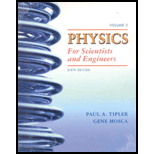
Concept explainers
(a)
The ray diagram for the two locations.
(a)
Explanation of Solution
Introduction:
The ray diagram is related to show the focal length
Draw a ray diagram to show the position of object, image and screen.

Conclusion:
Thus, the ray diagram is given above.
(b)
The focal length of the lens using Bessel’s equation.
(b)
Explanation of Solution
Given:
The object to image distance is
The distance between the two position of the lens is
Formula used:
Write the expression for focal length using Bessel’s method.
Here,
Calculation:
Substitute
Conclusion:
Thus, the focal length of the lens is
(c)
The two locations of the lens with respect to the object
(c)
Explanation of Solution
Given:
The object to image distance is
The distance between the two position of the lens is
Formula used:
Write the expression for the first lens equation.
Here,
Write the expression for the second lens equation.
Here,
Write the expression for the distance between object and screen for first lens.
Here,
Write the expression for the distance between object and screen for first lens.
Write the distance between the two lenses in terms of first image.
Here,
Write the distance between the two lenses in terms of second image.
Calculation:
Subtract equation (3) from equation (2).
Substitute
Rearrange the above equation.
Substitute
Add equation (3) to equation (2).
Substitute
Rearrange the above equation.
Substitute
Conclusion:
Thus, the two locations of the lens with respect to object are
(d)
The magnification of the images for two different positions of the lens.
(d)
Explanation of Solution
Given:
The object to image distance is
The distance between the two position of the lens is
The distance of the first object is
The distance of the second object is
Formula used:
Write the expression for the distance between object and screen for first lens.
Here,
Rearrange the above equation.
Write the expression for the distance between object and screen for first lens.
Rearrange the above equation.
Write the expression for the lateral magnification of the first image.
Here,
Write the expression for the lateral magnification of the second image.
Here,
Calculation:
Substitute
Substitute
Substitute
Substitute
Conclusion:
Thus, the magnification of the two images for two lens positions are
Want to see more full solutions like this?
Chapter 32 Solutions
Physics for Scientists and Engineers, Vol. 3
- A point source of light is 50 cm in front of a converging lens of focal length 30 cm. A concave mirror with a focal length of 20 cm is placed 25 cm behind the lens. Where does the final image form, and what are its orientation and magnification?arrow_forwardThe disk of the Sun subtends an angle of 0.533 at the Earth. What are (a) the position and (b) the diameter of the solar image formed by a concave spherical mirror with a radius of curvature of magnitude 3.00 m?arrow_forwardShow that the magnification of a thin lens is given by M = di/do (Eq. 38.6). Hint: Follow the derivation of the lens makers equation (page 1233) and start with a thick lens.arrow_forward
- A myopic person sees that her contact lens prescription is —4.00 D. What is her far point?arrow_forwardA converging lens has a focal length of 10.0 cm. Locate the object if a real image is located at a distance from the lens of (a) 20.0 cm and (b) 50.0 cm. What If? Redo the calculations if the images are virtual and located at a distance from the lens of (c) 20.0 cm and (d) 50.0 cm.arrow_forward(a) Where does an object need to be placed relative to a microscope for its 0.500 cm focal leng1h objective to produce a magnification of 400? (b) Where should the 5.00 cm focal length eyepiece be placed to produce a further fourfold (4.00) magnification?arrow_forward
- A convex mirror with a radius of curvature of 25.0 cm is used to form an image of an arrow that is 10.0 cm away from the mirror. If the arrow is 2.00 cm tall and inverted (pointing below the optical axis), what is the height of the arrows image?arrow_forwardYou can argue that a that piece of glass, such as in a window, is like a lens with an infinite focal length. If so, where does it form an image? That is, how are diand dorelated?arrow_forward(a) Calculate the focal length of the mirror formed by the shiny back of a spoon that has a 3.00 cm radius of curvature. (b) What is its power in diopters?arrow_forward
- If the cornea is to be reshaped (this can be done surgically or with contact lenses) to correct myopia, should its curvature be made greater or smaller? Explain.arrow_forwardA particular patients eyes are unable to focus on objects closer than 35.0 cm and corrective lenses are to be prescribed so that the patient can focus on objects 20.0 cm from their eyes. (a) Is the patient nearsighted or farsighted? (b) If contact lenses are to lie prescribed, determine the required lens power. (c) If eyeglasses are to be prescribed instead and the distance between the eyes and the lenses is 2.00 cm, determine the power of the required corrective lenses. (d) Are the required lenses converging or diverging?arrow_forwardThe magnification of an upright image that is 34.0 cm away from its object is 0.400. What type of lens is used to form the image, and what is its focal length?arrow_forward
 Principles of Physics: A Calculus-Based TextPhysicsISBN:9781133104261Author:Raymond A. Serway, John W. JewettPublisher:Cengage Learning
Principles of Physics: A Calculus-Based TextPhysicsISBN:9781133104261Author:Raymond A. Serway, John W. JewettPublisher:Cengage Learning College PhysicsPhysicsISBN:9781305952300Author:Raymond A. Serway, Chris VuillePublisher:Cengage Learning
College PhysicsPhysicsISBN:9781305952300Author:Raymond A. Serway, Chris VuillePublisher:Cengage Learning College PhysicsPhysicsISBN:9781285737027Author:Raymond A. Serway, Chris VuillePublisher:Cengage Learning
College PhysicsPhysicsISBN:9781285737027Author:Raymond A. Serway, Chris VuillePublisher:Cengage Learning
 Physics for Scientists and EngineersPhysicsISBN:9781337553278Author:Raymond A. Serway, John W. JewettPublisher:Cengage Learning
Physics for Scientists and EngineersPhysicsISBN:9781337553278Author:Raymond A. Serway, John W. JewettPublisher:Cengage Learning Physics for Scientists and Engineers with Modern ...PhysicsISBN:9781337553292Author:Raymond A. Serway, John W. JewettPublisher:Cengage Learning
Physics for Scientists and Engineers with Modern ...PhysicsISBN:9781337553292Author:Raymond A. Serway, John W. JewettPublisher:Cengage Learning





